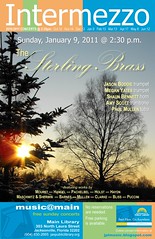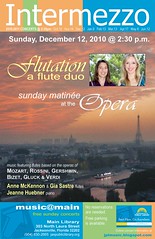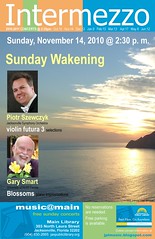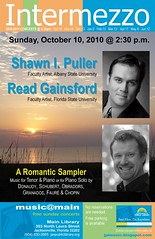The Sterling Brass
JASON BODDIE trumpet
MEGAN YATES trumpet
SHAUN BENNETT horn
AMY SCOTT trombone
PAUL MULLEN tuba
PROGRAM SELECTIONS
- MOURET: Rondeau (from Fanfares for Trumpets, Kettledrums, Violins and Oboes, Book 2)
- HANDEL: Where'er You Walk (from Semele)
- PACHELBEL: Canon in D
- HOLST: Suite No. 2 in F
- HANDEL: Three Selections from Water Music
- MASCHWITZ & SHERWIN: A Nightingale Sang in Berkeley Square
- HAYDN: Gloria (from Nelson Mass)
- TRADITIONAL: Three Spirituals (Arranged by Walter H. Barnes)
- CLARKE: Trumpet Voluntary
- BLISS: It is Well (with My Soul) (Arranged by Jason Boddie)
- PUCCINI: Nessun Dorma (from Turandot)
The Sterling Brass was newly formed in May 2010, and in addition to providing music for weddings and other private functions, the quintet is committed to introducing audiences to new music for brass quintet, and especially to introducing the genre to young audiences and inspiring young performers. More information is available at http://sterlingbrass.vpweb.com, as well as on facebook.com.
By day, Jason Boddie (trumpet) is in the Financial Services industry, but musically he is a regular at Frankie's Jazz Jam in Fernandina Beach, and he is a mentor to beginning brass players.
Besides performing with The Sterling Brass, Megan Yates (trumpet) is a nanny and a proud Navy wife.
Shaun Bennett (horn) has a degree in Music Theory and Composition from Jacksonville University, and his studies also included a semester at the New Zealand School of Music in Wellington, New Zealand. In addition to playing horn with the Coastal Symphony of Georgia in Brunswick, Shaun is the brass instructor at North Florida Music Academy in Orange Park, and teaches class piano in the after school program at LaVilla School of the Arts.
Amy Scott (trombone), a graduate of the University of Indianapolis, is a music educator and professional trombonist.
Paul Mullen (tuba) holds a Masters in Music Composition from the University of Missouri, and a degree in Music Theory from Stetson University. Paul teaches privately and is active as a clinician.
PROGRAM NOTES, by Ed Lein, Music librarianBy the time he was in his twenties, French Baroque composer Jean-Joseph Mouret (1682-1738) had become one of the most successful musicians living in Paris. But then, as now, musical styles were ever-evolving, and Mouret could neither adapt to changing musical tastes nor cope with his eventual fall from fashion, and when he died he was penniless and confined to an insane asylum. Although the majority of his works remain virtually unknown, today one would be hard-pressed to name another piece from the French Baroque more recognized than this Rondeau, thanks to its becoming the trademark theme music for PBS's Masterpiece Theatre in 1971.
George Frideric Handel (1685-1759) ranks with J.S. Bach (1685-1750) and Antonio Vivaldi (1678-1741) as among the most enduring Baroque-period composers. Born in Germany as Georg Friedrich Händel, he settled in London in 1712, anglicized his name and became a naturalized British subject. Handel's sacred oratorio, Messiah (1741), unquestionably contains some of the most-recognized music in the history of Western music and was an immediate success. With Semele (1743), the ever-adaptable Handel hoped to find similar success, advertising the decidedly operatic work as an English "oratorio"--but its mythological subject matter disappointed those Lenten concertgoers hoping for religious edification, and it likewise disappointed opera aficionados who craved both Italian lyrics and elaborate costumes and staging. Despite the blurring of styles, the Act 2 aria, Where'er You Walk, originally sung by Jupiter, is one of Handel's most frequently-performed non-Messiah arias.
Today Johann Pachelbel (1653-1706) is considered among the most important German musicians of the generation preceding Bach and Handel, and even though his influence as a composer was not far-reaching, he enjoyed considerable success as composer, organist and teacher during his lifetime. Originally for three violins and basso continuo and paired with a Gigue movement, Pachelbel's Canon in D became extraordinarily popular during the last couple of decades of the 20th century, most especially after Marvin Hamlisch (b. 1944) adapted it as the theme music for the 1980 film, Ordinary People.
British composer Gustav Holst (1874-1934) composed over 200 works, but in America his fame with the general public rests squarely on his brilliant orchestral suite, The Planets (1920). That being said, Holst's two Suites for Military Band (1909 and 1911, respectively) remain cornerstones of the band repertoire. The Second Suite, Op. 28, no. 2, uses British folk tunes for its thematic inspiration.
Handel composed his famous Water Music as entertainment for a 1717 boating party for England's King George I, who, in Germany as Prince-Elector Georg, had been Handel's employer a few years before the monarch traded up to Buckingham Palace (or wherever it was that he hung his freshly-shined crown). Because Handel had taken residence in London prior to George's British ascendancy, rumor had it that the composer wrote Water Music as a peace offering to his "abandoned" former prince, but in all likelihood Handel probably moved when he did with the future king's sympathetic blessing.
With lyrics by Eric Maschwitz (1901-1969) and music by Manning Sherwin (1902-1974) and Jack Strachey (1894-1972), the World War II-era British ballad, A Nightingale Sang in Berkeley Square, is a long-established popular standard. Composed in 1939 and introduced to London audiences in a 1940 musical review, the song has been championed by many American performers, including Nat “King” Cole, Frank Sinatra, Bobby Darrin and Harry Connick, Jr., and an arrangement recorded by the Manhattan Transfer won a Grammy in 1981.
Genial Austrian composer (Franz) Joseph Haydn (1732-1809) is the musician most credited with establishing the “Classical” style that his two younger contemporaries Mozart and Beethoven built upon, and by the time of his death "Papa" Haydn had become the most widely celebrated composer in Europe. Nicknamed the “Nelson Mass” in honor of Britain’s Admiral Horatio Nelson, Haydn’s Missa in Angustiis ("Mass for troubled times," Hob. XXII:11) premiered in 1798, shortly after Lord Nelson had dealt the first hard blow to Napoleon’s intended world domination. The Mass has been singled out as Haydn’s finest work, and its second movement Gloria has rightly been called an unqualified “song of exultant praise.”
Walter H. Barnes has made numerous arrangements for brass instruments in association with what is perhaps the most famous brass quintet of all, the Canadian Brass, including this set of African-American Spirituals. Originally published in 1872 by the Fisk Jubilee Singers, Go Down Moses was made especially famous by bass-baritone Paul Robison (1898-1976), and was also used by British composer Michael Tippett (1905-1998) in his 1941 war-time oratorio, A Child of Our Time. The serenely beautiful My Lord What a Morning provided the title for the autobiography of famed contralto Marian Anderson (1897-1997), and the vigorously exuberant Joshua (Fit the Battle of Jericho) is a natural for brass instruments, as it relates the triumphant felling of an enemy’s fortress by the sounding of trumpets!
The best-known piece by British composer and organist Jeremiah Clarke (ca. 1674-1707) was mistakenly identified as “Trumpet Voluntary by Henry Purcell” until the 1940s, when finally it was discovered that this popular choice for wedding processionals was in fact a keyboard piece by Clarke, a younger contemporary of the much more famous Purcell (1959?-1695). Published in 1700 as Prince of Denmark’s March, its good-natured jauntiness belies the composer’s ultimately morbid disposition—unrequitedly unlucky in love, the unhappy composer shot himself when he reportedly was otherwise unable to decide between his two most-preferred suicidal methods, drowning and hanging.
The tune for It Is Well with My Soul was composed by American hymnist Philip Bliss (1838-1876) to words written by Chicago attorney Horatio Spafford (1828-1888) after his four daughters drowned when the steamship Ville du Havre sank en route to Europe in 1873. Apart from its use in churches, Georgia Southern University's Southern Pride marching band plays the song at their sporting events, and rock versions have been recorded by two bands, Audio Adrenaline (in 1999), and Kutless (in 2009).
Giacomo Puccini (1858–1924) came from a long line of Italian church musicians, and it was assumed he’d inherit the “family business” in Tuscany. But a fateful trek from Lucca to Pisa to see Verdi’s Aïda convinced Puccini to give up organ pedals for footlights, and he became the only real successor of Verdi in the realm of Italian opera. When he died of throat cancer the whole of Italy went into mourning, and no opera composer since has enjoyed the same kind of sustained international following that Puccini still has. Based on a folktale from The Arabian Nights, Puccini’s exotic final opera, Turandot, was left unfinished at his death, but that hasn’t stopped its 3rd-act aria, Nessun dorma (“None shall sleep”), from becoming the biggest-ever “crossover” hit, owing primarily to the international commercial success of Italian tenor Luciano Pavarotti (1935-2007). Although he rarely performed in stage productions of the entire opera, Nessun dorma became Pavarotti’s signature song, and when he was too sick to receive his Lifetime Achievement Award during the 1998 Emmy broadcast, the legendary Aretha Franklin (b. 1942) stepped in and provided a soulful live tribute performance of the aria (in the original key!), in a thrilling, non-operatic style uniquely her own.









